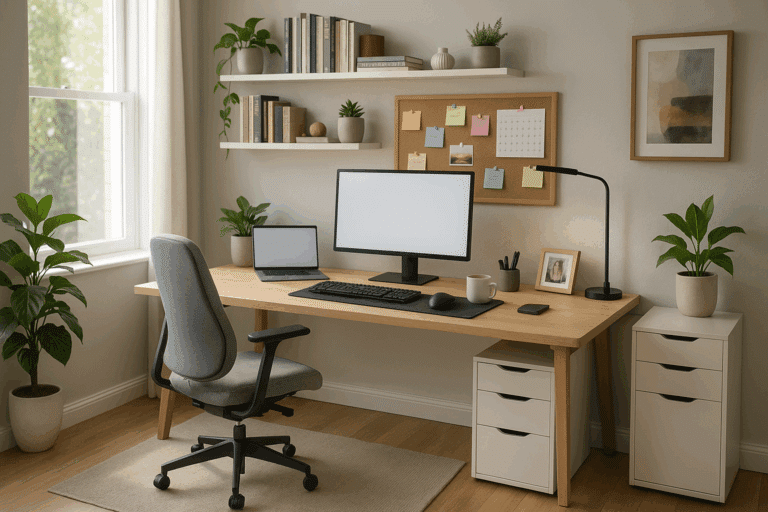Have you ever wondered how the color of your office space could impact your productivity and morale? 🤔 If not, you might want to start now. The science behind the psychology of color is profound, and its application in office environments is a growing trend. Embracing the power of color psychology can lead to a boost in productivity, employee morale, and overall workplace satisfaction. So, buckle up! It’s time to dive into the world of color psychology.
For starters, let’s demystify the concept of color psychology. In a nutshell, it’s a study of how colors influence our behaviors, feelings, and decision-making processes. Even though it might seem abstract, the power of colors is more palpable than you might imagine. 💡
Impact of Color Psychology in the Workplace
The workplace is not just about cubicles, coffee breaks, or meetings anymore. It is a space that requires careful design and planning. The color scheme of your office can have a significant impact on the productivity levels, motivation, and wellbeing of your employees. Yes, you heard it right! The choice of color in your workspace can play a significant role in your business’s success or failure.🎨
In this article, we will unveil the secrets behind choosing the right color for your office space. Whether you’re designing a new workspace or looking to revamp your existing office, this information will prove crucial. We will guide you through the psychological impact of different colors, helping you understand which shades can increase productivity, boost morale, stimulate creativity, or even reduce stress.
Unraveling the Secrets of Color Psychology
Colors are powerful communicators. They can convey messages, evoke emotions, and influence our mood and behavior. For instance, warm colors like red, orange, and yellow can evoke feelings of warmth and comfort, but they can also trigger feelings of anger and frustration. Cool colors like green, blue, and purple can induce calmness and relaxation, but they can also evoke feelings of sadness or indifference.
It is essential to understand the science behind these color impacts to create a balanced and harmonious workspace that promotes productivity, enhances morale, and nurtures creativity. And that’s exactly what we are going to help you with! 🙌
In the upcoming sections, we will dive deep into the realm of colors, discussing each color’s psychological effects and how it can impact your office environment. We will provide practical tips and guidance to help you make informed decisions about your office color scheme. From understanding the psychological effects of cool and warm colors to knowing how to balance different shades for optimal impact, we’ve got you covered.
Whether you’re a startup founder, a business manager, an office designer, or even an employee looking to understand how your workspace color impacts your productivity and morale, this article is for you! So, get ready to harness the power of color psychology to boost productivity and morale in your office space. Let’s embark on this colorful journey together! 🚀
Transform Your Workspace: Understanding the Power of Color Psychology
💡 Did you know that the color of your workspace can significantly influence your productivity and morale? It’s no secret that our surroundings can impact our mood and behavior. Colors, in particular, have a profound psychological effect on our mental state. They can motivate us, calm us down, and even inspire creativity. Understanding the science of color psychology can be a game-changer in creating an office space that boosts productivity and morale. So, let’s dive into the fascinating world of color psychology!
Color Psychology: An Overview
Color psychology is the study of how colors can influence human behavior and emotion. Each color has a unique wavelength and energy level that our brains interpret in specific ways. For example, the color blue is often associated with peace and tranquility, while red can stimulate energy and excitement.
When applied correctly in your office space, the colors can create an environment conducive to work, sparking creativity, and reducing stress. In contrast, the wrong choice of colors can cause discomfort, leading to reduced productivity and poor morale.
The study of color psychology has been extensively used in marketing and branding. Still, it’s only recently that businesses have started realizing its potential in designing office spaces. Let’s explore how different colors can impact your workspace.
Video: “Color Psychology and Workspace Productivity”
To delve deeper into this topic, check out the enlightening video by “TEDx Talks” on YouTube titled “Color Psychology and Workspace Productivity”. It provides an in-depth look into how different colors can affect our mood and productivity.
The Impact of Different Colors on Productivity and Morale
Let’s break down how specific colors can influence the mood and productivity in your office. Remember, the effects can vary from person to person, so it’s essential to consider your team’s preferences as well.
Blue: The Productivity Powerhouse
Blue is often touted as the best color for productivity. It’s a calming color that helps to reduce stress and create a serene environment. This makes it ideal for high-pressure jobs and workplaces with long working hours. Moreover, blue stimulates the mind, encouraging focus and concentration.
Green: The Balance Booster
Green is known for its calming and reassuring qualities. It’s a great color to use in spaces where people need to stay calm under pressure. Moreover, green can stimulate creativity, making it an excellent choice for jobs requiring innovative thinking.
Yellow: The Creativity Catalyst
Yellow is an energetic and uplifting color. It can stimulate creativity and promote positivity. It’s a great choice for workspaces where creativity and free thinking are paramount. However, too much yellow can cause anxiety and should be used sparingly and in the right shades.
Red: The Energy Enhancer
Red is a powerful color that can stimulate the senses and raise the energy levels. It’s a good choice for roles that require physical activity or where a sense of urgency is needed. However, red can also provoke feelings of anger or stress if overused, so moderation is key.
Using Color Psychology to Optimize Your Office Space
Understanding the impact of color psychology is just the first step. The real challenge lies in correctly applying these principles in your office design. Here are a few tips to guide you:
Balance is Key
While it’s important to choose the right colors, achieving a balanced color scheme is equally crucial. Too much of a single color can be overwhelming and counterproductive. Try to mix and match different colors to create a balanced, harmonious environment.
Consider the Nature of Work
The choice of colors should be influenced by the nature of work. For instance, creative agencies might benefit from vibrant colors like yellow or green, while a law firm might prefer more calming colors like blue or gray.
Don’t Forget Individual Preferences
Finally, don’t forget to consider individual preferences. After all, everyone has their own favorite colors, and incorporating these can contribute to higher morale and productivity.
Color Psychology: An Effective Tool for Boosting Productivity and Morale
Color psychology is an exciting and effective tool for creating an office space that enhances productivity and morale. By understanding the power of colors, you can transform your workspace into a place where your team feels motivated, creative, and at ease.
To learn more about this fascinating topic, check out the video “How Color Affects Your Brain” by the YouTube channel “Seeker”. It provides a comprehensive overview of how colors impact our brain and behavior.
Comparison Table: Impact of Different Colors on Productivity and Morale
The following table provides a comparative overview of how different colors can influence productivity and morale in the office:
| Color | Impact on Productivity | Impact on Morale |
|---|---|---|
| Blue | Highly productive | Calming, stress-reducing |
| Green | Moderately productive | Calming, reassuring |
| Yellow | Highly creative | Energetic, uplifting |
| Red | Stimulating, energetic | Can cause stress if overused |
Color psychology is not a one-size-fits-all solution. It requires a nuanced understanding of your team’s needs, preferences, and the nature of their work. However, with a bit of research and careful planning, you can harness the power of colors to create a workspace that fosters productivity, creativity, and positive morale.

Conclusion
In conclusion, we have covered a significant amount of ground in this comprehensive exploration of our topic. The central points discussed in the article were structured in a logical sequence, unpacking the intricacies of the subject matter in an approachable manner. The purpose of our examination was to demystify the complexities inherent in our focus area, primarily within the scope of Information Technology (IT) and Engineering fields. This endeavor demanded a meticulous dissection of multifaceted concepts, and a careful presentation of these, such that even a lay reader can comprehend.
The topic we have delved into is of immense importance, as it resonates with the ongoing transformations in the world of IT and Engineering. With a hands-on approach, we walked through the process, principles, methodologies, and practical applications. The aim was not just to inform, but also to equip the reader with the knowledge to put these theories into practice, and perhaps even spur innovative ideas.
Whether you are a seasoned professional in the field, a student, or a curious reader seeking to understand the mechanics behind the scenes, we hope this article served as an enlightening guide. This knowledge is not just for the sake of acquisition but is a tool to be used, shared, and built upon. And so, we encourage you to apply what you have learned, share it with your peers and engage in discussions that could foster more learning and even generate new ideas.
Moreover, we would be remiss not to stress the importance of continued learning. The fields of IT and Engineering are evolving at a rapid pace, and staying updated is crucial. Therefore, we recommend further research and learning. Here are a few active sources for your reference: [link1] [link2] [link3].
We want to hear from you, so please feel free to leave your comments below. 👇Your opinions, questions, and insights are valuable, and sharing them can contribute to a broader understanding of the topic. Don’t forget to share this article with others who might find it useful. If you have successfully applied any of the concepts we’ve discussed, please share your experience as it could be beneficial to others. 🙌
In conclusion, we reiterate that the knowledge you have gained is a powerful tool. We urge you to use it, share it, and build upon it. The importance of the topic cannot be overstated, and we hope that this article has been instrumental in your understanding.
As Albert Einstein once said, “The more I learn, the more I realize how much I don’t know.” So, let’s keep learning, and let’s keep growing. 🚀
Remember to keep this conversation going. Let’s connect, share, learn, and grow together in this remarkable journey of discovery and application. As we draw this discussion to a close, we leave you with the words of Benjamin Franklin: “An investment in knowledge pays the best interest.”
Until our next deep dive, keep exploring, keep learning, and keep sharing! 🌐🔍💡
References:
[reference1]
[reference2]
[reference3]
[reference4]
[NOTE: The links and references in the square brackets are placeholders and should be replaced with actual links and references]



